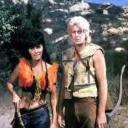Yahoo Answers is shutting down on May 4th, 2021 (Eastern Time) and beginning April 20th, 2021 (Eastern Time) the Yahoo Answers website will be in read-only mode. There will be no changes to other Yahoo properties or services, or your Yahoo account. You can find more information about the Yahoo Answers shutdown and how to download your data on this help page.
Trending News
Why don't asteroids, like comets, plunge toward sun?
11 Answers
- 8 years ago
Most comets have circular orbits that never approach the sun. Only a very tiny percentage of them have been nudged out of their orbits in a way that brings them close to the sun. And these are temporary, since the sun eventually evaporates them completely.
Comets exist way out in the Oort cloud, far from the sun where it's cold, which is why they're made mostly of ice. It's like a shell of trillions of snow balls slowly orbiting the sun. Occasionally, however, gravitational interactions will slow one down in its orbit and fall into the inner solar system. If its new orbit carries it close to the sun, it will become a comet.
Most asteroids, however, are native to the inner part of the solar system where the planets reside. SInce their orbital speed is higher, it's harder for gravitational interactions to nudge them into a different orbit. They also contain less ice if any, so they don't become visible when they get near the sun.
- poornakumar bLv 78 years ago
Asteroids are bodies confined in a belt with a mean distance of 2.8 AU. In XVIII century Bode & Titius observed that the orbits starting from Mercury, follow a particular scheme. They found an approximate formula that describes the distance of each from the Sun, as per the formula
4 + 3(2ᶯ); n = 0,1, 2, 3 .. ...
where n as the index increments by 1 for every successive orbital slot.
the same divided by 10 gives the distance in AU. Let's call it
R = [4 + 3(2ᶯ)] /10
Mercury is left out at '4'; R = 0.4. For the others
Venus : n = 0, R = 0.7 AU,
Earth : n =1, R = 1 AU,
Mars : n = 2, R = 1.6 AU,
.... .. : n = 3, R = 2.8 AU,
Jupiter: n = 4, R = 5.2 AU,
Saturn: n = 5, R =10.0 AU.
That was the list of the known planets then in which one slot was vacant at 2.8 AU (for n = 3). A furious search ensued. On the midnight hour of a new year & new Century, January 1, 1801 the discovery of new planet was announced by Piazzi at his Palermo observatory in Sicily. It was given the name of the Roman goddess of crops, "Ceres". Ceres has a diameter of 940 km & accounts for a third of the mass of this swarm of rocks & irregular chunks that was named "Asteroids". Ceres is a dwarf Planet.
Since these are very small bodies (in size & mass) they are perturbed a lot by the nearby Jupiter. Their disturbed orbits takes them to inner orbits. Some of them graze past earth's orbit as NEO (Near Earth Objects).
Comets populate the region beyond Neptune in the Kuiper belt & are too numerous in the Oort Cloud that extends till 50000 AU (=0.790 light year); with 'a' , semi-major axis reaching 20000 AU & extremely high eccentricity.
- Anonymous8 years ago
Most are in stable orbits around the sun (like the planets) so unless something disturbs their orbits there is no reason for them to plunge into the sun.
The laws of physics are quite simple.
- ?Lv 48 years ago
If they did, they would be comets and not asteroids. It is how they act which gives them their name - not the other way around. But I think I see where you're going with the question. All the planets, moons, comets, and asteroids in space are acted on by gravity. And according to the theory of gravity that Isaac Newton came up with the only ways for things to move are in what they call conic sections. Things can only go in circles (like some planets, asteroids, or moons), or ellipses and hyperbolae (like comets).
- How do you think about the answers? You can sign in to vote the answer.
- 8 years ago
Many do, but some projectiles in space are either too large or going at a rate of speed so fast that the sun's pull is not enough to pull it in
Source(s): My guess - duke_of_urlsLv 78 years ago
The reason they don't is that they are revolving around the Sun, and that balances with the gravity between these bodies and the Sun.
The reason they are revolving around the Sun is as yet unknown.
- Newdivide1701Lv 78 years ago
Sone actually do. But since they are rocks and not dirty snowballs, then they would not produce a tail like what is associated with comets.






